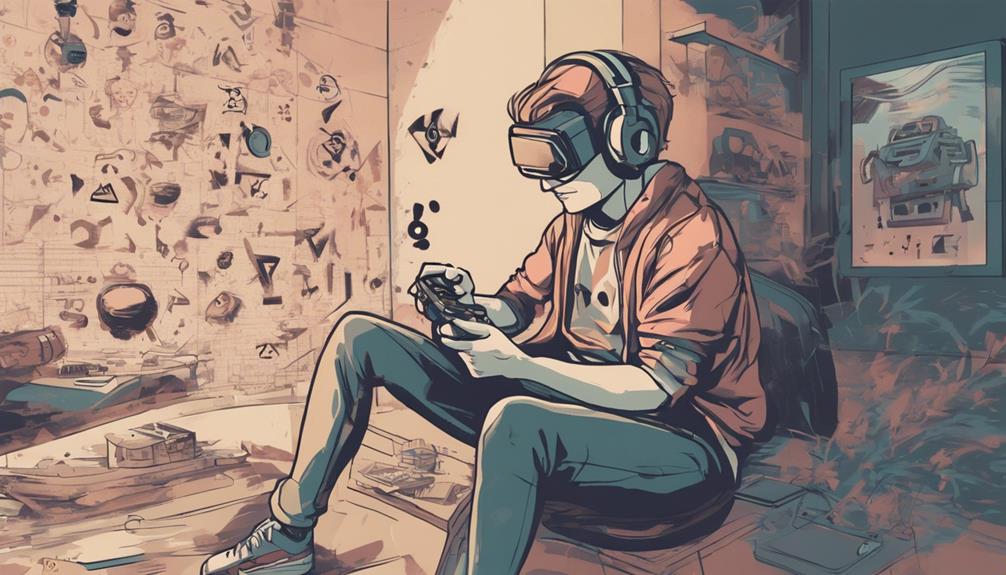Subliminal games subtly influence players through hidden triggers that target the subconscious mind, impacting behaviors and emotions without conscious awareness. These hidden cues are strategically placed to evoke specific responses, guiding players towards desired actions and shaping their in-game decisions. The interplay between game design and human psychology is intricate, with subliminal elements playing a significant role in player immersion and engagement. Understanding these subtle influences is essential for experiencing truly immersive gaming experiences. Explore further to uncover the depths of subliminal messaging in popular games and the ethical considerations surrounding subliminal game design.
The Psychology Behind Subliminal Gaming

Analyzing the psychological mechanisms at play in subliminal gaming reveals intricate processes of perception and cognitive processing. Subliminal gaming operates on the premise of influencing players through hidden triggers embedded within game mechanics. These hidden triggers are designed to tap into the player's subconscious influences, ultimately enhancing player immersion within the game world.
Player immersion is an essential aspect of gaming, as it denotes the extent to which a player feels mentally absorbed and emotionally invested in the gaming experience. By incorporating subliminal elements such as subtle visual cues or background sounds, game developers can effectively manipulate player emotions and behaviors without the player consciously realizing it.
Understanding the psychology behind subliminal gaming involves delving into how these hidden triggers interact with the player's cognitive processes. It sheds light on the power of subliminal messages to shape player perceptions and decision-making within the game environment. Ultimately, the integration of subliminal elements in gaming highlights the intricate interplay between game design and human psychology.
Uncovering Subliminal Messages in Popular Games
In popular games, the presence of subliminal messages can be detected through careful observation and systematic analysis. Hidden agendas and player manipulation are often intertwined within the intricate design of these games. The gaming industry strategically incorporates elements that exert subconscious influence on players, affecting their perceptions and behaviors without their conscious awareness.
Subliminal messages in games can manifest in various forms, such as subtle imagery, cryptic audio cues, or disguised symbols. These hidden elements are strategically placed to evoke specific emotions or prompt certain actions from players, shaping their overall gaming experience. By tapping into the subconscious mind, game developers can influence player decision-making processes and guide them towards desired outcomes.
The prevalence of subliminal messages in popular games underscores the sophisticated techniques employed by the gaming industry to engage and retain players. Understanding the impact of these hidden cues is essential in comprehending the immersive nature of gaming experiences and the extent of player susceptibility to subconscious influences.
Impact of Subliminal Cues on Player Behavior

The integration of subliminal cues in popular games has been shown to greatly influence player behavior, shaping their decisions and interactions within the gaming environment. Player manipulation through subconscious influence is a powerful tool that game developers utilize to evoke specific behavioral responses.
By embedding hidden triggers within the game's visuals, sounds, or even gameplay mechanics, developers can subtly guide players towards desired actions or decisions without the players consciously realizing it.
Research has indicated that subliminal cues can impact various aspects of player behavior, such as their in-game choices, strategic approaches, and emotional responses. For example, a study found that players exposed to subliminal messages related to aggression displayed more competitive behavior in multiplayer games compared to those who were not exposed to such cues.
These findings highlight the significant role that subliminal cues play in shaping player behavior and the potential implications for game design and player engagement.
Ethical Considerations in Subliminal Game Design
An examination of the ethical implications surrounding the incorporation of subliminal stimuli in game design reveals complex considerations that warrant careful scrutiny. When considering player autonomy in the context of subconscious influence, game designers must navigate ethical dilemmas. The use of subliminal cues raises concerns about manipulating player behavior without their explicit awareness or consent, potentially undermining players' ability to make informed choices.
Game design ethics demand a balance between engaging gameplay mechanics and respecting player agency. Subliminal messages that subtly influence decisions can blur the line between fair game design and manipulation. Designers must weigh the potential benefits of enhancing player experience against the risks of breaching ethical boundaries.
Ensuring transparency and providing players with control over their gaming experiences are pivotal in addressing ethical concerns related to subliminal game design. By fostering open dialogue and adhering to principles of respect for autonomy, designers can navigate the complexities of subconscious influence while upholding ethical standards in game development.
How to Spot Subliminal Messages in Games

Detecting subliminal messages in games requires a keen eye for subtle cues and patterns that may influence player behavior without conscious awareness. Hidden imagery and subconscious influences are common tools used in game design to engage players on a deeper level. These subliminal messages are strategically embedded to evoke specific emotions, thoughts, or actions in players without their explicit realization.
One method to spot subliminal messages in games is to pay attention to any repeated symbols, colors, or sounds that seem out of place or overly emphasized. These could be covert persuasion techniques aimed at manipulating player behavior.
Additionally, sudden changes in gameplay dynamics or visual elements may also indicate the presence of subliminal messages designed to subconsciously guide player decisions.
Conclusion
In the complex world of subliminal gaming, hidden messages lurk beneath the surface like shadows in the night, influencing player behavior in ways unseen.
The impact of these cues on the psyche of gamers is profound, raising ethical questions about the boundaries of game design.
By unraveling the mysteries of subliminal messages in games, we shed light on the intricate web of psychological manipulation that shapes the gaming experience.




